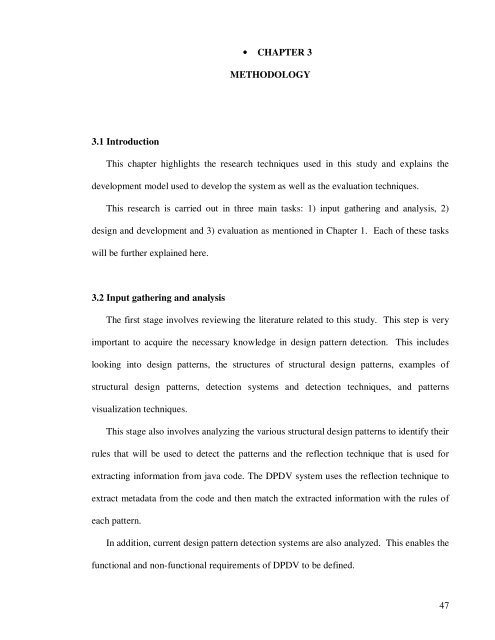47 • CHAPTER 3 METHODOLOGY 3.1 Introduction ... - DSpace@UM
47 • CHAPTER 3 METHODOLOGY 3.1 Introduction ... - DSpace@UM
47 • CHAPTER 3 METHODOLOGY 3.1 Introduction ... - DSpace@UM
Create successful ePaper yourself
Turn your PDF publications into a flip-book with our unique Google optimized e-Paper software.
ConcurrentactivitiesSpecificationInitialVersionOutlinedescriptionDevelopmentIntermediateVersionsValidationFinalVersionFigure <strong>3.1</strong>: Evolutionary Prototyping model (Sommerville, 2007)3.<strong>3.1</strong> Development model for DPDVAs shown in Figure <strong>3.1</strong>, the evolutionary prototyping model consists of interleavedactivities that are specification, development and validation. Each activity will be explainedin the following section:1) Specification: specification concerns about understanding the requirements and definingthem. The requirements of DPDV have been identified by studying the existing designpatterns detection systems and meetings with the supervisor. In this stage, the functionaland non-functional requirements of DPDV are defined.2) Development: the development activity is an iterative process till an adequate systemhas been achieved. DPDV system is developed iteratively. The first and second versions ofDPDV were refined to eventually produce the final version3) Validation: The purpose of evaluation is to ensure that DPDV meets the systemrequirements. Each version of the DPDV system was validated by users.49
3.3.2 DesignThe design of DPDV is captured through the several refinement of the prototype. Thedesign of DPDV includes system architecture design, data structure design, algorithmdesign, and user interface design (Refer to Chapter 5).3.4 EvaluationThe purpose of evaluation is to ensure that DPDV system conforms to its specificationand meets its functional and non-functional requirements. Evaluation of DPDV consists oftesting the system using different types of testing that includes unit testing, integrationtesting, system testing, and user acceptance testing. The iterative evaluation process ofDPDV has resulted in development of three versions of DPDV. The final version is theadequate version that can be used for detection of patterns effectively.3.5 SummaryThis chapter explained the research techniques used in this study. It showed the threemain tasks of constructing this research that are input gathering and analysis, design anddevelopment, and evaluation as mentioned. Moreover, it explained the use of evolutionaryprototyping model in the development of the DPDV system.50
















